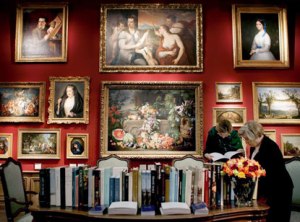Art Investment: The Cold Hard Truth pt. 1 – artmarketblog.com
I have read and heard so much incorrect information regarding art investment of late that I think it is about time that the cold hard truth about art investment is made available. So, here it goes.
The answer to this question depends on how much money you have to invest. Only a very small percentage of the works of art in existence will experience an increase in value that is rapid enough and sufficient enough to provide the investor with a worthwhile return on their investment. Those works of art that can provide a good return are inevitably going to cost significant sums of money due to the fact that the characteristics that make a work of art a good investment are really only found in highly valued works of art. There is really no inexpensive way of successfully investing in art. Another option is to invest in a fine art fund, which essentially allows investors to purchase a share in a managed portfolio of carefully selected works of art. Once again, however, the minimum investment for such funds is quite high at around the US$250,000 mark, which is more than the average person is likely to be able to afford. The other problem with fine art funds is that the investors do not get to experience any of the pleasures of owning the works of art which, quite frankly, is one of the very few benefits of art investment. It is fair to say that people who want to buy art generally want to see it and enjoy it. That is, unless one has enough money to be able to invest in a fine art fund and purchase art for their own pleasure. Investors in fine art funds should expect to get a 10-15% a year return on their investment according to Philip Hoffman, manager of an art fund called The Fine Art Fund. Proper art investment, ie. using fine art to generate a worthwhile return on your investment, is really only a pursuit for the wealthy as success really is relative to the amount of money one can invest. For those that do have the money, however, the returns can be quite high and the risk quite minimal.
Can I successfully invest in contemporary art?
Since contemporary art appears to be relatively cheap compared to the work of, say, the old masters, it is often presumed that buying contemporary art is an easy and Large profits can be made from investing in contemporary art, but investing in contemporary art is a very risky business. Successful investment in contemporary art usually requires a “flipping” approach that involves buying and selling works in relatively quick succession to take advantage of short term trends. This approach is very, very risky and requires that the investor have large sums of money to invest that he/she is willing and able to lose. Not only does one need lots of money and bravery to be a successful “flipper”, one also needs to have the right knowledge and contacts at hand, which very few people do. With the right advisor it is possible to profit from investing in contemporary art over the long term but the risks are still high. What it comes down to is that there are plenty of way better investment vehicles for those investors who are wanting high risk with the potential for high returns. In other words, contemporary art is not a good investment.
To be continued………..
 **Nicholas Forrest is an art market analyst, art critic and journalist based in Sydney, Australia. He is the founder of http://www.artmarketblog.com, writes the art column for the magazine Antiques and Collectibles for Pleasure and Profit and contributes to many other publications
**Nicholas Forrest is an art market analyst, art critic and journalist based in Sydney, Australia. He is the founder of http://www.artmarketblog.com, writes the art column for the magazine Antiques and Collectibles for Pleasure and Profit and contributes to many other publications
Filed under: art, art auction, art investment, art investment fund, art investor, art market | Tagged: art, art investment, art market, artist, auction, investment, museum | 6 Comments »



































